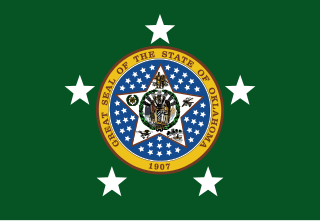Top Qs
Timeline
Chat
Perspective
Flag of Oklahoma
U.S. state flag From Wikipedia, the free encyclopedia
Remove ads
The flag of the U.S. state of Oklahoma, also known as the Oklahoma flag, is a rectangular field of sky blue on which is placed an Osage war shield with six crosses and seven pendant eagle feathers above the name of the state in a white Eurostile text in all capitals. Superimposed onto the crosses of the war shield is a calumet (peace pipe) and an olive branch.[1]
Remove ads
History
Summarize
Perspective

Oklahoma's first flag was adopted in 1911, four years after statehood. The flag featured a large centered white star fimbriated in blue on a red field. The number 46 was written in blue inside the star, as Oklahoma was the forty-sixth state to join the Union.[2] It was designed by Ruth Dickinson Clement, a founder of the state branch of the Daughters of the Confederacy.
In 1916, a member of the 1st regiment of the Oklahoma National Guard gave the University of Oklahoma their old regimental flag. The flag bore the state's coat of arms.[3]
A contest, sponsored by the Daughters of the American Revolution, was held in 1924 to replace the flag, as red flags were closely associated with the red flag of communism. The winning entry by Louise Fluke, of Shawnee, Oklahoma, which was adopted as the state flag on April 2, 1925, resembled the current flag without the word Oklahoma on it. That word was added in 1941[4] as part of an effort to combat widespread illiteracy,[5] although there is no evidence the change to the flag played any significant role in such.
|
Remove ads
Design
Summarize
Perspective
The official design of the flag of Oklahoma has remained the same since 1941, however, unauthorized flag designs became prevalent throughout the state, so much so that the correct and official design of the flag was becoming lost. These unauthorized flags displayed stylized eagle feathers, incorrectly shaped crosses, an incorrectly shaped pipe, wrong colors, or combinations of these and other errors. In 2005, an Oklahoma Boy Scout leader designing patches for a National Jamboree contingent was looking for an image of the Oklahoma state flag and noticed that there were multiple unauthorized designs of the Oklahoma state flag displayed on state government, historical, and educational websites. With some research he was able to identify the official design to use, but because of the prevalence of unauthorized designs, he contacted his state representative,[6] and was the impetus to standardize the colors and shapes by Oklahoma Senate Bill 1359[7] and signed into law by Governor Brad Henry on May 23, 2006, taking effect on November 1, 2006.[7]
In 2001, the North American Vexillological Association surveyed its members on the designs of the 72 U.S. state, territorial, and Canadian provincial flags and ranked the Oklahoma flag 39th.[8]
Remove ads
Symbolism


The flag of Oklahoma is one of two U.S. state flags (along with New Mexico) to depict distinct Native American iconography.[note 1] The blue field represents devotion and loyalty. The shield surmounted by the pipe and olive branch represents defensive or protective warfare, showing a love of peace by a united people.[9] The flag of Oklahoma closely resembles the flag of the Choctaw Nation carried into battle by men of the Second Indian Brigade or "Choctaw Brigade" during the American Civil War.[10] The Choctaw flag, a replica of which hung in the Oklahoma Historical Museum, having been described as a rectangular field of blue, on which was placed a large red circular war shield bordered by a band of white; superimposed upon the face of the shield was a white bow, two arrows, and tomahawk crossed at right angles.[11]
Display and use
In 2015, a new specialty license plate honoring the first flag was authorized by the legislature and signed into law. A minimum of 100 pre-orders were required and fulfilled.[12] Later in 2024 the first flag license plate with the addition of Route 66 landmarks became the new standard Oklahoma license plate.
Salute
The state legislature adopted the following salute to the flag in 1982:
"I salute the Flag of the State of Oklahoma: Its symbols of peace unite all people."
Remove ads
Flag of the governor of Oklahoma

The Oklahoma governor's flag consists of a green field charged with the seal of Oklahoma, surrounded by a pentagram of five white stars.[13] The five stars symbolize the Five Civilized Tribes. The flag was officially adopted in 1957 and is used as a symbol to mark the presence of the governor of Oklahoma.
See also
Notes
- The Florida and Massachusetts flags contain state seals depicting Native people.
References
Further reading
External links
Wikiwand - on
Seamless Wikipedia browsing. On steroids.
Remove ads







